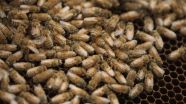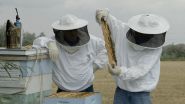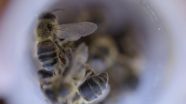Using microscopic bugs to save the bees
Preventing hive collapse is the goal
2014-10-27
(Press-News.org) For decades, honeybees have been battling a deadly disease that kills off their babies (larvae) and leads to hive collapse. It's called American Foulbrood and its effects are so devastating and infectious, it often requires infected hives to be burned to the ground.
Treating Foulbrood is complicated because the disease can evolve to resist antibiotics and other chemical treatments. Losing entire hives not only disrupts the honey industry, but reduces the number of bees for pollinating plants.
Now researchers at BYU have produced a natural way to eliminate the scourge, and it's working: Using tiny killer bugs known as phages to protect baby bees from infection.
"Phages are the most abundant life form on the planet and each phage has a unique bacteria that it will attack," said Sandra Burnett, BYU professor of microbiology and molecular biology. "This makes phage an ideal treatment for bacterial disease because it can target specific bacteria while leaving all other cells alone."
Although phages are plentiful in nature, finding the perfect phage for the job takes a lot of hunting. That's where student Bryan Merrill comes in.
Merrill has been researching ways to treat American Foulbrood since joining a "Phage Hunters" class his freshman year at BYU. Merrill loved the class, which introduced him to the process of phage identification, and so he approached Burnett with hopes of researching treatment for the disease under her tutelage.
"This bacteria has been a problem in honeybees for a long time," Merrill said. "It infects the larva when they're teeny tiny. Even a few spores will infect and they'll start eating the larva from the inside out. It doesn't hurt the adult bees, but all of the sudden the bees can't replenish the population and the hive just collapses."
When hives are infected, beekeepers generally treat their hives with antibiotics. However, this is usually only a temporary solution. If the bacteria returns, it will most likely develop to be resistant to the antibiotics. From there, bee owners have the option to burn the hive or try phage treatment.
"Phage is a great alternative to antibiotics, and it's a natural alternative because phages exist in nature on their own," Burnett said. "And just the nature of a phage itself is that it's self-replicating at the expense of the bacteria. It multiplies itself so there are more of them to hunt down the bacteria. Then as soon as the host is gone, the phage just disappears."
Once they identify the perfect phage, Burnett, Merrill and other students replicate it in the lab so it can be applied to the hive with a sugar-water solution. Like a virus, the phage get to work infecting the harmful bacteria until it is gone.
After a lot of gene sequencing and analyzing, Merrill has identified five phage candidates for honeybee treatment, cleverly named after former BYU basketball stars (Abouo, Davies, Emery, Jimmer1 & Jimmer2). His findings appear in a recent issue of high ranking biotechnology journal BMC Genomics.
INFORMATION:
ELSE PRESS RELEASES FROM THIS DATE:
2014-10-27
Parents can learn to use a scientifically validated autism therapy with their own children by taking a short series of group classes, a new study by researchers at the Stanford University School of Medicine and Lucile Packard Children's Hospital Stanford has found.
The therapy helped children improve their language skills, an area of deficiency in autism, according to the study, which will be published Oct. 27 in the Journal of Child Psychology and Psychiatry. The study is the first randomized, controlled trial to test whether group classes are a good way to train parents ...
2014-10-27
You don't always need GPS, a map or a compass to find the right way. What demands a tremendous amount of computational power from today's navigation computers can also be achieved by taking advantage of the laws of physical chemistry and practicing so-called "chemical computing". The trick works as follows: A gel mixed with acid is applied at the exit of a labyrinth – i.e. the destination – filled with alkaline liquid. Within a shorttime, the acid spreads through the alkaline maze, although the majority of it remains together with the gel at the exit. When an ...
2014-10-27
WASHINGTON, Oct. 27, 2014 — It's a spooky question, but it doesn't have to be: What happens when you die? Even after you depart, there's a lot of chemistry that still goes on inside you. Reactions teamed up with mortician Caitlin Doughty, author of the new book "Smoke Gets in your Eyes, and Other Lessons from the Crematory" to demystify death and talk about exactly what happens to the body postmortem. Check out the new episode here: http://youtu.be/BpuTLnSr_20.
Subscribe to the series at Reactions YouTube, and follow us on Twitter @ACSreactions to be the first to ...
2014-10-27
When Hurricane Sandy struck the east coast in late October 2012, the "superstorm" disrupted traffic in New York City for more than five days, but the evacuation proceeded relatively efficiently with only minor delays, according to transportation researchers at the University of Illinois. The largest Atlantic hurricane on record, Hurricane Sandy offered a chance for researchers at the University of Illinois at Urbana-Champaign to try out a new computational method they developed that promises to help municipalities quantify the resilience of their transportation systems ...
2014-10-27
WASHINGTON, DC—The American Academy of Pediatrics (AAP), American Academy of Family Physicians (AAFP), American College of Physicians (ACP) and American Osteopathic Association (AOA) convene today in Washington, DC to urge Congress to extend current-law payment parity for primary care and immunization services under Medicaid for at least two years. Absent congressional action, federal support for this policy runs out at the end of the year. Collectively representing nearly 423,000 physicians, the four groups are meeting with dozens of congressional offices on Capitol ...
2014-10-27
New Rochelle, NY, October 27, 2014—More than half of women with children less than a year old are working, and work travel can make breastfeeding a challenge. A study of 100 U.S. airports found that few provided a suitably equipped, private lactation room, even though most described themselves as being breastfeeding friendly, as reported in Breastfeeding Medicine, the official journal of the Academy of Breastfeeding Medicine published by Mary Ann Liebert, Inc., publishers. The article is available free on the Breastfeeding Medicine website at http://online.liebertpub.com/doi/full/10.1089/bfm.2014.0112 ...
2014-10-27
This news release is available in French. A key to aortic valve disease prevention: Lowering cholesterol early
Montreal, Sunday 26, 2014 – An international research team led by the Research Institute of the McGill University Health Centre (RI-MUHC) and Lund University has provided new evidence that aortic valve disease may be preventable. Their findings show that so-called "bad" cholesterol or low-density lipoprotein-cholesterol (LDL-C) is a cause of aortic valve disease – a serious heart condition that affects around five million people in North America ...
2014-10-27
New York | Heidelberg, 27 October 2014 Thermodiffusion, also called the Soret effect, is a mechanism by which an imposed temperature difference establishes a concentration difference within a mixture. Two studies1,2 by Belgian scientists from the Free University of Brussels, recently published in EPJE, provide a better understanding of such effects. They build on recent experimental results from the IVIDIL (Influence Vibration on Diffusion in Liquids) research project performed on the International Space Station under microgravity to avoid motion in the liquids.
In the ...
2014-10-27
Case Western Reserve University mental health researcher Joseph Galanek spent a cumulative nine months in an Oregon maximum-security prison to learn first-hand how the prison manages inmates with mental illness.
What he found, through 430 hours of prison observations and interviews, is that inmates were treated humanely and security was better managed when cell block officers were trained to identify symptoms of mental illness and how to respond to them.
In the 150-year-old prison, he discovered officers used their authority with flexibility and discretion within ...
2014-10-27
EAST LANSING, Mich. --- The job market for new college graduates may be heating up fast, but starting salaries will see only modest growth, a Michigan State University economist says in a new study.
About six in 10 employers say they will keep starting pay the same as last year for newly minted degree-holders. The remainder will offer salary increases, on average, of a modest 3 percent to 5 percent, said Phil Gardner, author of Recruiting Trends, the nation's largest survey of employers' hiring intentions for college graduates.
"Pressure on employers to increase starting ...
LAST 30 PRESS RELEASES:
[Press-News.org] Using microscopic bugs to save the bees
Preventing hive collapse is the goal






